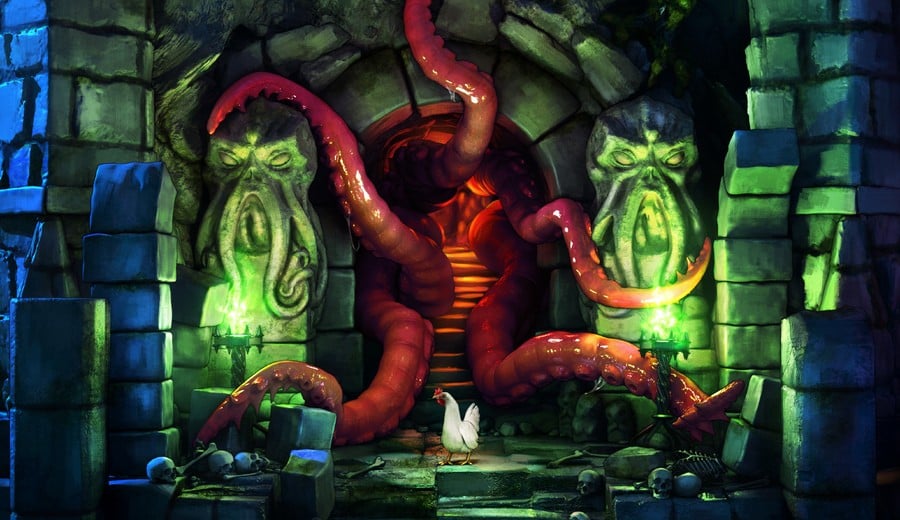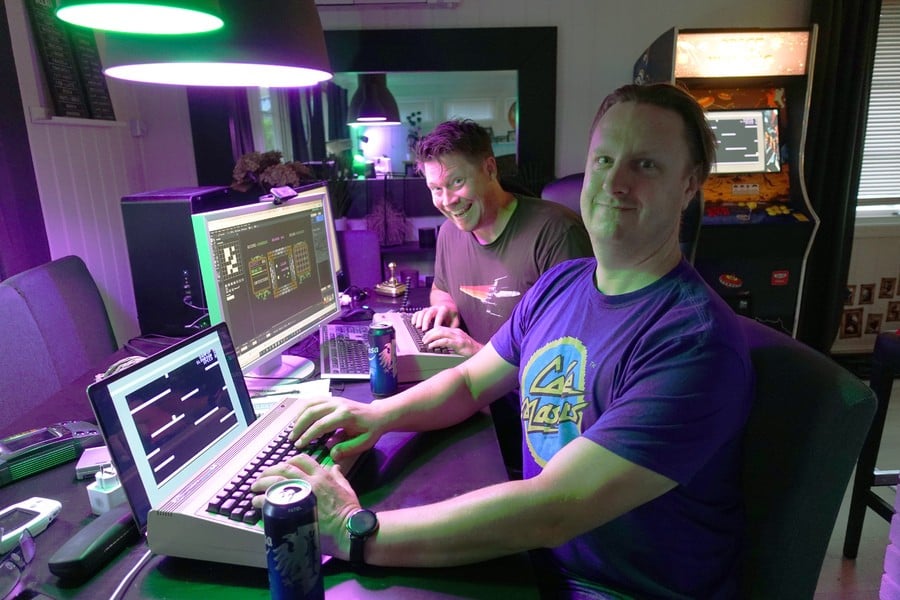
We don't think it's an exaggeration to call Roguecraft one of the most hotly anticipated Amiga games in recent memory
Created by the Norwegian development studio Badger Punch Games, it is an ambitious follow-up to the spectacular Commodore 64 homebrew Rogue 64 — a game that earned a ton of praise upon its release in 2022 from indie outlets as well as from more mainstream outlets like Destructoid.
As its name suggests, the game is a roguelike inspired by the works of HP Lovecraft and sees players exploring a maze of dungeons as one of three character archetypes (a fighter, a rogue, or a mage), in search of unimaginable treasure. Along the way, there are various secrets, items, and enemies to encounter, with the ultimate goal being to navigate the various levels and kill the tentacled monster hiding out at the end.
The first we heard that Badger Punch was working on a follow-up to Rogue 64 was at the beginning of 2023, but it was actually announced even earlier than that, with the devs teasing the logo as early as September 2022. Since then, we've been eagerly anticipating updates about the game and were excited earlier this month to see it finally go on pre-order, with the help of Thalamus Digital.
The game is now expected to be released later this year, in September, so we thought it might be a good time to have a chat with its two core developers, the programmer Ricki Sickenger and artist Henning Ludvigsen, to discuss their incredible development journey so far. They gave us a little more context on how Badger Punch was originally formed, why they wanted to develop a new title for the Amiga, and why the game has taken a bit longer to make than initially expected.
Time Extension: Can you tell us a bit about Badger Punch Games? How did the core team come together?
Ludvigsen: We got to know each other in the early 90s, as we were both members of the same Amiga demo group. We’re both based in Norway, but we live on opposite sides of the country. Ricki’s in the west and I'm in the East.
In the late 90’s both of us started working on an MMORPG game called Darkfall Online with a bunch of other friends. To make a really long and complicated story very short, it basically ended up with us moving to Athens, Greece to merge with another company and to make the game, and it took almost 10 years of really hard work. Towards the end, Ricki moved back to Norway while I was stuck there for a little bit longer. We kept in touch daily and just started working on a small game for Xbox Indie Live, just for fun. And that’s when Badger Punch Games became a reality. And we’ve just kept going since then. Still, just as a side project, just for fun.

Time Extension: Obviously, as you mentioned, Roguecraft isn’t the team’s first game. You’ve released multiple projects across a wide range of platforms in the past, including Commodore 64. What made you want to tackle a project for Amiga machines? What is your own personal history with the hardware?
Sickenger: I got my Amiga 500 around 1990, after having a C64 for a few years. I immediately started teaching myself 68k assembly and started making small intros and other things in assembly, [before] getting into the Amiga demoscene. I have fond memories of coding on the Amiga, and after making a few games on the C64 I really wanted to get back into assembly on the Amiga. The Amiga hits the sweet spot for me regarding capabilities and what you can accomplish on it as a hobby project. It really is a cool machine to make things for.
After making a few games on the C64 I really wanted to get back into assembly on the Amiga. The Amiga hits the sweet spot for me regarding capabilities and what you can accomplish on it as a hobby project
Ludvigsen: My own personal history with the Amiga was getting a taste of it by borrowing my big brother’s Amiga 1000 without permission. However, I was using the C64/C128 for a few more years before finally getting my hands on an Amiga CDTV, which I will admit was a strange choice. Still, it was enough to get me hooked on creating music and pixel art and getting introduced to (and included) in the demo scene. At a later point, I replaced the CDTV with an Amiga 1200, and I stepped up my game even further. I still have my lovely A1200 to this day.
Time Extension: What have been some of the advantages and disadvantages of working with the Amiga hardware?
Sickenger: The big advantage compared to the C64, is that the Amiga is much faster and has dedicated coprocessors that lighten the load for the CPU. The blitter makes it pretty easy to add a lot of moving graphics on the screen, and the ability to set up your own 32-color palette lets us customize the colors to the game. Henning did an excellent job of making a palette and graphics that really showcase the Amiga’s graphical capabilities.
The main disadvantage I guess is that it is easy to get a bit over-ambitious when developing for the Amiga. That would be okay in a commercial sense, but not when you're trying to make games as a hobby while having a job and other commitments. Roguecraft was supposed to take about 6 months to develop and ended up taking 2 years. Also, the coprocessors like the Blitter and Copper add a layer of complexity to the coding that can get in the way before you gain experience with the Amiga architecture.
Time Extension: On your website, Roguecraft is described as an enhanced version of Rogue 64 — a game that you previously released for the Commodore 64. What were some of the main things you wanted to incorporate into this expanded version of the game to take advantage of the more powerful hardware?
Sickenger: With Roguecraft we wanted to explore the possibilities of the Amiga hardware, so we changed to isometric graphics and added quite a few new things while keeping the same gameplay as Rogue64.
Using the isometric style we were able to add a lot more detail to the dungeons and the monsters. Also, using an isometric view just gave us more depth to the visuals.
Time Extension: We’re huge fans of the game’s pixelated isometric graphics. How did you develop the look of the game? What were the influences you drew on?
Ludvigsen: We wanted to give using an isometric view a try, as we’ve never really done anything like that earlier. There are no real influences to the visuals, except that we do love the Lovecraftian universe, and thought it would be cool to use that as an inspiration. There’s also where the name “Roguecraft” came from; It’s a Rogue-style game set in the Lovecraft universe. The style just happened organically over time — as the palette gradually got established so did the visual style.
Time Extension: What other tools are you using for this project? Is it mostly bespoke stuff or are there any common toolsets you’re taking advantage of?
Sickenger: Each room is pre-made in a lovely program called Tiled. Tiled supports isometric tilesets, and helped us enormously. We have scripts that convert the Tiled room data into assembly data so they can be used in-game.
Ludvigsen: For the pixel art, I’m using Photoshop. I found a YouTube tutorial called 'HD Index Painting in Photoshop' by “Dan Fessler which really helped me establish a pipeline that worked for me. We tweaked this pipeline to work well with our limited 32-color Amiga palette. The cool thing with this workflow is that you can work pretty much non-destructively in Photoshop using most of the tools and still stay within the established 32-color palette. We’re also using Tiled for building the rooms based on the tile sets we’re creating, which has worked tremendously well.

There are over 100 room variations, and as you progress in the game, the rooms get more dark and gritty. That keeps the levels from feeling too repetitive.
Time Extension: Let’s talk about the dungeons in the game. The game features randomly generated levels. Could you explain how these were built? What were some of the rules you set in place to ensure these were fun to play and not needlessly repetitive?
Sickenger: We used some common techniques and some simplifications to generate the dungeons. Every level in the dungeon is a 5x5 grid of rooms. The randomizing algorithm removes a room at a time, and then for each room it has removed, it checks that you still can access every room from every other room. That means we haven’t split the dungeon in two. If the dungeon has been split, we re-add the room and randomly pick another room to remove. We keep doing this until we have reached the minimum number of rooms, or until we have had to re-add rooms a certain number of times. Rooms are placed in the dungeon depending on how many exits they have and where they fit. There are over 100 room variations, and as you progress in the game, the rooms get more dark and gritty. That keeps the levels from feeling too repetitive.
Time Extension: Just as a final question, how much work is still left to do on the game at this stage? How are you feeling about things as you’re getting closer to the release?
Ludvigsen: The game is done, and it has been for quite a while. The pre-orders for the physical boxes opened on July 1st, which is exciting!
As a developer, there are always things that you know about and would have loved to keep polishing on, but we’ve focused on not falling into crazy amounts of feature creep and keeping a fairly basic and hopefully fun game experience.
From what we’ve seen so far, the reviews and feedback have been overwhelmingly positive which is more than we ever hoped for, so we’re currently just hoping that we’ve squished all the bugs before the big release. Also, releasing the game under the legendary Thalamus Digital banner is something we're nerding out about.
If you're interested in checking the game out, Roguecraft is currently available to pre-order now from Thalamus Digital's website in three different versions. Pre-orders are expected to be fulfilled in September 2024. The list of compatible Amiga machines includes the A500 (ECS Agnus), A500+, A600, A1200, A2000 (ECS Agnus), A3000, A4000, and CD32. More information can be found here.
